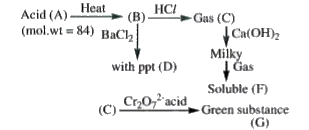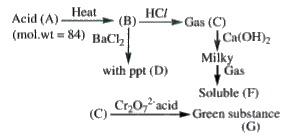Passage - V:

Reaction, C→G is Solution in Telugu
hydrolysis
neutralization
precipitation
Redox reaction
The correct Answer is:D
NaHSO3(mol.wt=104)Δ−−→Na2SO3(B) ↓BaCl2Ba2SO3with ppt (D)HCl−−→NaCl+SO2(C) ⏐↓Ca(OH)2CaSO3Milky ↓SO2+H2O Ca(HSO3)2 (G)
Topper's Solved these Questions
- VIA GROUP ELEMENTSBOOK - AAKASH SERIESCHAPTER - VIA GROUP ELEMENTSEXERCISE - LEVEL-II LECTURE SHEET (EXERCISE-III Match the following questions)
10 Videos
- VIA GROUP ELEMENTSBOOK - AAKASH SERIESCHAPTER - VIA GROUP ELEMENTSEXERCISE - LEVEL-II LECTURE SHEET (EXERCISE - IV Integer answer type Questions)
9 Videos
- VIA GROUP ELEMENTSBOOK - AAKASH SERIESCHAPTER - VIA GROUP ELEMENTSEXERCISE - LEVEL-II LECTURE SHEET (EXERCISE-I Single & One or More than One Correct Answers)
29 Videos
- VA GROUP ELEMENTSBOOK - AAKASH SERIESCHAPTER - VA GROUP ELEMENTSEXERCISE - PRACTICE EXERCISE
51 Videos
- VII GROUP ELEMENTSBOOK - AAKASH SERIESCHAPTER - VII GROUP ELEMENTSEXERCISE - OBJECTIVE EXERCISE -4
55 Videos
Similar Questions
COLUMN-ICOLUMN-II(A)SO2(p)+2 and '0' states of 'S' (B)H2S(q)Trimer solid(C)SO3(r)Reductant(D)S6O(s)Oxidant(t)sp2sulphur
View SolutionThe atomicities of oxygen and sulphur are different. What is the ratio of the atomicities of sulphur to oxygen ?
View SolutionWhat is the difference in maximum atomicity of oxygen and sulphur?
View SolutionWhich of the following reacts rapidly with oxygen in the air at ordinary temperature?
View Solution(A): The bond dissociation energy of fluorine is less than bromine.
(R): In fluorine molecule, large lone pair electronic repulsions and appreciable internuclear repulsions are present.
View SolutionIf for a reaction in which A(g) converts to B(g) the reaction carried out at const. V & T results into the following grapg.
View SolutionFor the reaction A(g)⇔B(g),KC=10
B(g)⇔C(g),KC=2
C(g)⇔D(g),KC=0.01
Calculate KC for the reaction D(g)⇔A(g).
View SolutionFor the reaction, A(g) rarr B(g) +C(g) Select the correct graph.
View SolutionHeat of reaction for, CO(g)+1//2O_(2)(g)rarr CO_(2)(g) at constant V is -67.71 K cal at 17^(@)C . The heat of reaction at constant P at 17^(@)C is :-
View SolutionWrite the balanced equations for the following reactions : (v) N2(g)+H2(g)⇔NH3(g)
View SolutionE.M.F. of following cell is 0.265 V at 25∘C and 0.2595 V at 35∘C. Calculate heat of the reaction taking place at 25∘CPt(H2)|HCl(g)||AgCl|Ag(s)
View SolutionThe relation between KPandKC for the reaction A(g)+B(g)⇔C(g)+2D(g) is -
View SolutionHeat of reaction for, CO(g) 1/2 O_(2)(g) rarr CO_(2)(g) at constant V is -67.71 kcal at 17^(@)C . The heat of reaction at constant P at 17^(@)C
View SolutionPassage - V:

Reference to the above flow diagram Gas (C ) is
View SolutionFor the reaction A(g) iff B (g), K_(C)=10 B(g) iff C(g), K_(C)=2 C(g) iff D(g), K_(C)=0.01 Calculate K_(C) for the reaction D(g) iff A(g) .
View Solution
